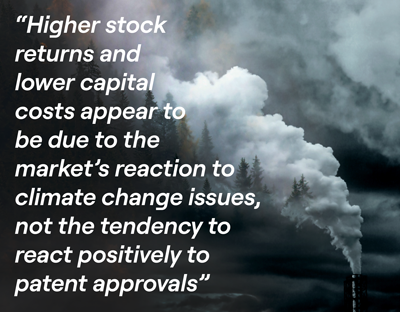Investors are ever more focused on environmental issues, pushing firms to reduce carbon dioxide and other greenhouse gas emissions. But how can we evaluate the impact of corporate efforts to promote the energy transition? Demonstrating the cutting-edge economic analysis employed at TSE Energy & Climate Center, Ulrich Hege and Sébastien Pouget teamed up with TSE alumnus Yifei Zhang (Peking University) to study how financial markets respond to climate innovation.
Why is it hard to assess corporate climate action and its impact on markets?
Establishing a causal link between corporate climate mitigation and financial market effects is very difficult. Firms may have many characteristics that correlate with their environmental rating and future stock returns. For example, firms with a better management team may be both more likely to manage their environmental performance well and to enjoy higher future returns.
Measurement errors are another major obstacle to empirical research. ESG ratings appear to display high levels of disagreement. The low level of correlation across ratings suggests they are noisy measures of firms’ underlying ESG performance. Measurement errors may also be caused by greenwashing, when firms manipulate their reporting to conceal negative information or exaggerate their environmental performance.
How does your paper address these challenges?
We focus on innovation in climate change mitigation, studying the award of patents that protect inventors’ exclusive rights to make, use or sell their discoveries. We exploit the fact that the US patent office (USPTO) uses a specific code (“Y02”) for climate-related technologies, such as renewable energy generation or carbon capture. Rigorous scrutiny by the USPTO mitigates some of our concerns that greenwashing may distort our analysis.
A key tool in our empirical strategy is our use of quasi-random variation in the probability of patent approvals. Existing research shows that some examiners are more lenient and grant patents more easily. Most USPTO examiners are also assigned to patent applications in a quasi-random fashion. Combining these two facts allows us to separate the effect of ‘lucky’ patent approvals from that of the underlying technologies. We can then compare firms with lucky climate-related patents to similarly innovative but unlucky firms, exploring the reaction of financial markets, ESG-minded investors and the ESG rating ecosystem.
What are your key findings?
 We show that companies with more lucky climate-related patents enjoy substantially higher cumulative abnormal stock returns – about 10% over the next 12 months, or approximately 2% per patent – as well as lower capital costs. Importantly, these results hold especially during periods of high attention towards climate change and for initial climate patent granting.
We show that companies with more lucky climate-related patents enjoy substantially higher cumulative abnormal stock returns – about 10% over the next 12 months, or approximately 2% per patent – as well as lower capital costs. Importantly, these results hold especially during periods of high attention towards climate change and for initial climate patent granting.
Using a daily index of the coverage and negativity of climate topics in US newspapers, we find that abnormal returns after lucky patent approvals are around 20% higher in periods of heightened climate attention. The drop in cost of capital is also most pronounced when climate concerns are salient. This suggests that higher stock returns and lower capital costs are due to the market’s reaction to climate change issues, not the tendency for markets to react positively to patent approvals or a decrease in a firm’s exposure to risks such as environmental litigation or scandals.
What are the driving forces behind the market response?
We show that institutional investors react strongly in favor of climate patent approvals. This is driven by environment-focused institutional investors who reallocate their portfolios and reinforce their holdings in the lucky companies. As with stock returns, these reallocations are substantially higher during periods of increased climate concern.
Patent approval therefore appears to be interpreted by ESG-minded institutional investors as an ESG signal indicating that firms are making efforts towards climate change mitigation. Companies with climate-related patents also benefit from increased environmental scores from ESG rating agencies. Interestingly, our results do not carry over to other green patents – for example, in areas such as air pollution or water treatment – that fall outside a narrow definition of climate tech. This is perhaps because these patents lack a specific USPTO tag.
Is the market right to reward climate patent holders? Do they contribute to climate mitigation and reduce emissions?
When we look at random variations in patent approvals, we find no measurable impact on the carbon emissions of the innovating companies. This is in line with the idea that firms that have been unlucky in the patent lottery still have access to new climate technologies that are on average as effective as those of lucky firms. However, when we dispense with the lottery approach to instead study the impact of the underlying technology, we find significant reductions in innovators’ carbon emission intensity.
We conclude that climate innovation allows innovators to mitigate their climate impact, but these gains are linked to the underlying technology itself, not to patent approval. Financial market participants and ratings agencies appear to regard patent approvals as noisy but informative signals: an interpretation that is supported by our finding of a positive climate impact of the underlying green technology.
FURTHER READING
‘The Impact of Corporate Climate Action on Financial Markets’ and other publications by Ulrich and Sébastien are available to read on the TSE website.
Article published in TSE Reflect, May 2023







